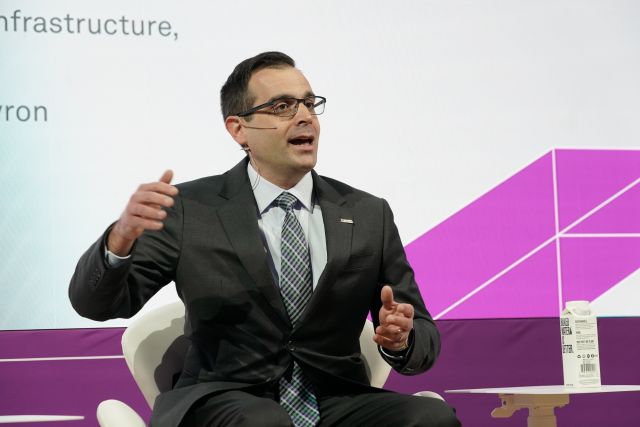
Michael Ducker, senior vice president of hydrogen infrastructure for Mitsubishi Power, at CERAWeek by S&P Global. (Source: CERAWeek by S&P Global)
The massive hydrogen and energy storage project known as ACES Delta, or the Advanced Clean Energy Storage hub project in Delta, Utah, is on track to start operations in the first half of 2025, a project partner said March 20.
Speaking during CERAWeek by S&P Global, Michael Ducker, senior vice president of hydrogen infrastructure for Mitsubishi Power, said the project is still on schedule and continues to progress. Showing photos of gas turbines being constructed and electrolyzers arriving via train, Ducker said it is incredibly impressive to see three major infrastructure projects—a power plant, hydrogen production and hydrogen storage—come together.
The project, with hydrogen storage caverns about the size of the Empire State Building, could serve as a blueprint for the application of seasonal energy storage in the U.S. and elsewhere. But it had to overcome obstacles.
“As with any major infrastructure projects going on in today’s environment, no doubt we’ve seen challenges. Anybody that tries to tell you that they’ve been developing and constructing a project post-COVID [in an] inflationary environment [with] supply chain constraints without any issues would be a liar, I would say,” Ducker said. “No doubt we’ve faced adversity. But great news is, the way we overcome that is through partnerships” and collaboration.
Initially, ACES Delta will convert more than 220 megawatts (MW) of renewable energy into 100 metric tonnes per day of green hydrogen to be stored in two gigantic 4.5-MMbbl salt caverns. The caverns will store hydrogen, providing long-duration energy storage to be dispatched when needed to the grid.
Project challenges included difficulty obtaining certain pipelines and programmable logic controllers (PLC), which is a device that essentially tells a valve to open or close, according to Ducker.
“We couldn’t find them,” he said about the PLCs. “This was a challenge and this is stuff that the industry historically has never considered a critical path or issue. And yet we had to overcome that,” he said, noting its engineering, procurement and construction contractor helped resolve the issue.
The project will provide fuel via pipeline for Intermountain Power Agency’s (IPA) 840-MW combined cycle gas turbine power plant, which is adjacent to the ACES Delta hub. IPA’s IPP Renewed Project is set to replace a retiring 1,800-MW coal-fired power plant, a move the U.S. Department of Energy (DOE) has said is estimated to help prevent more than 126,500 metric tons of CO2 emissions annually. The IPP Renewed project’s gas turbines will run on 30% hydrogen fuel at startup in 2025, but Mitsubishi aims to increase that percentage to 100% by 2045.
Michael Hoban, general manager of hydrogen for Chevron, called ACES a story of convergence. Chevron, which last year acquired ACES Delta owner Magnum Development and joined the project, is focusing on hydrogen as well as renewable fuels, carbon capture, renewables and offsets as part of its lower carbon solutions efforts.
“You’ve got a customer in this case, IPA, doing a massive project, and they’re looking to lower the carbon intensity of their operations,” Hoban said. “You also have this convergence of technology both in terms of production of electrolytic hydrogen, also co-firing hydrogen with gas turbines.”
In addition to the geologic features unlocking hydrogen as a long-term storage mechanism is a partnership working to put together the pieces of the puzzle, he added.
Each storage cavern will have about a 150 gigawatt-hours equivalent of energy storage, Ducker said.
“Just to put that in perspective when this project closed in June of 2022, the entire United States had roughly three gigawatt hours of lithium-ion batteries installed across the entire United States,” he said. “So, our one site here with two caverns that are under construction right now, 300 gigawatt hours. It’s a hundred times the entire United States’ installed lithium-ion battery capacity in this one site. … The scale and magnitude [are] tremendous.”
One salt cavern alone has the capacity to store the entire state of California’s monthly curtailed energy, according to ACES Delta’s website. The project is located in Utah but is electrically connected to Southern California.
Recommended Reading
Utica’s Infinity Natural Resources Seeks $1.2B Valuation with IPO
2025-01-21 - Appalachian Basin oil and gas producer Infinity Natural Resources plans to sell 13.25 million shares at a public purchase price between $18 and $21 per share—the latest in a flurry of energy-focused IPOs.
What's Affecting Oil Prices This Week? (Feb. 3, 2025)
2025-02-03 - The Trump administration announced a 10% tariff on Canadian crude exports, but Stratas Advisors does not think the tariffs will have any material impact on Canadian oil production or exports to the U.S.
Utica Oil Player Ascent Resources ‘Considering’ an IPO
2025-03-07 - The 12-year-old privately held E&P Ascent Resources produced 2.2 Bcfe/d in the fourth quarter, including 14% liquids from the liquids-rich eastern Ohio Utica.
Utica Oil’s Infinity IPO Values its Play at $48,000 per Boe/d
2025-01-30 - Private-equity-backed Infinity Natural Resources’ IPO pricing on Jan. 30 gives a first look into market valuation for Ohio’s new tight-oil Utica play. Public trading is to begin the morning of Jan. 31.
The New Minerals Frontier Expands Beyond Oil, Gas
2025-04-09 - How to navigate the minerals sector in the era of competition, alternative investments and the AI-powered boom.
Comments
Add new comment
This conversation is moderated according to Hart Energy community rules. Please read the rules before joining the discussion. If you’re experiencing any technical problems, please contact our customer care team.






